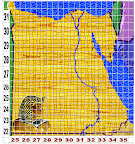Merneptah-Stele-Translation-or-Perversion
Many people repeat what they read because they actually believe it, but after they find it is false and continue to repeat it, should we label them scholars, Egyptologist or should we label them liars.
Ahmose autobiography, The door jamb from Tell el-Dab'a, Khamudy hieroglyphics, Merneptah Stela
... all said to identify Asiatics, Hyksos or Israelites.The hieroglyphic said to have that meaning in Ahmose autobiography does not exist in any of the other hieroglyphics.
The hieroglyphic said to have that meaning in the door jamb from Tell el-Dab'a does not exist in any of the other hieroglyphics.
The hieroglyphic said to have that meaning in the Khamudy hieroglyphics does not exist in any of the other hieroglyphics.
The hieroglyphic said to have that meaning in the Merneptah Stela does not exist in any of the other hieroglyphics.
In the multiple hieroglyphic sources said to have the word Asiatic, how is it all the words in the sources are different hieroglyphic spellings?
=============================
When a population encounters a population of a different language, they can learn the meanings of each other's words.
When a population attempts to hide the meaning of their words or the population speaking that language no longer exists, then the process of code breaking is used.
Code breaking works by finding patterns. Trying to find out what a word of another language also is a search for patterns .... and if/when some of the words are known, the meanings of words can be found by looking at in the context.
* If an unknown word is in a sentence and there is no information in the sentence to identify the meaning ... there is no understanding of that word.
* If a word is only found once in a language (with no accompanying information) the meaning of that word can never be known.
* If a word is found many times in different writings, then the examination of the word in each context will be evidence of it's possible meaning.
=============================
A source of hieroglyphics was found in 1896 and the glyphs on a line was translated to foreigners .... decades later in 1976 another 'expert' translated the same glyphs to Israel.
How did they get "Israel" out of foreigners?
Amalekites, Amorites, Arvadites, Edomites, Girgashites, Hamathite, Hittites, Horites, Ishmaelites, Jebusites, Kadmoites, Kenizzites, Midianites, Moabites, Perizzites, Philistines, Zemarites ... ALL of these and More tribes were foreigners and they were in Canaan, so how does these experts, chose Israel to be the foreigners and change the translation?
Does this source of hieroglyphics state they were circumcised, does it say they would not work on a certain day of the week, does the hieroglyphic say they performed burnt sacrifices.. NO, NO, NO !
Ashkelon is conquered, Gezer seized, Yanoam made nonexistent; the foreigners are wasted, bare of seed, Khor is become a widow for Egypt.
I would suggest you find any one who translates that word to Israel, to find that set of glyphs in ANY OTHER EGYPTIAN HIEROGLYPHS or to explain how they determined those particular foreigners can be identified as Israelites.... Take all challengers, ask them to have a trained translator of hieroglyphics to publish how they concluded the word identifies Israel and see if they will sign their name to their assertion on a public web page.
=============================
The Merneptah Stele is non-descript. There is NO information to identify those foreigners as "Amalekites, Amorites, Arvadites, Edomites, Girgashites, Hamathite, Hittites, Horites, Ishmaelites, Jebusites, Kadmoites, Kenizzites, Midianites, Moabites, Perizzites, Philistines or Zemarites" .. NOTHING in the context to identify that word as Israel.
Identifying that word as Israel would be as idiotic as reading an account about a football fan throwing a beer bottle at a ref.
What fan, goofy? The one with his hand in the air? NO, to remove a word from the abstract/unknown to the defined department, there would have to be a unique identification that identified them.
The guy with his hat on backwards, would eliminate all girls and all who did not have their hat on backwards.
Why would any one inject the word Israel, when there is NOTHING to identify that word as Israel? To appease the religious who invent evidence for their make believe stories.
Why would any one who knows there is NO evidence that word is Israel, jump on the band wagon and promote that BS?
I guess it is more fun to jump on the band wagon and get along with the ignorant or liars, then it is to be truthful?
It is quite funny how they call the Merneptah Stele, "The Israel Stele" when there are only 5 words in the complete context and none of these words are identified as Israel.
IF a word is only found once in an unknown language and there is nothing in the context to identify it's meaning, then it's meaning is UNKNOWN !
If a word is found multiple times in an unknown language, then the linguist can examine the word in the multiple context and get an insight of the word's meaning.
Show how any translator arrived at the decision the word in the Merneptah Stele identifies Israel, then show us the name of the translator, their translation training and where they will testify to the meaning of this word in a public web page.
=============================
This is only one example of the concocted definitions used by BSERS who call themselves scholars/Egyptologist.
~
zendz










